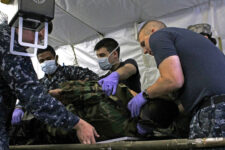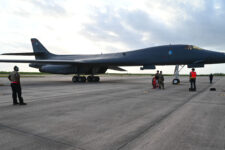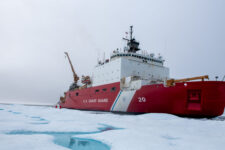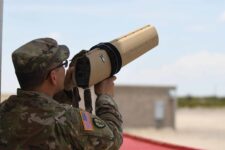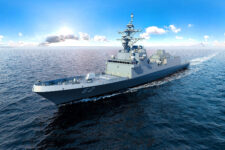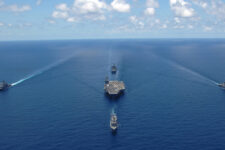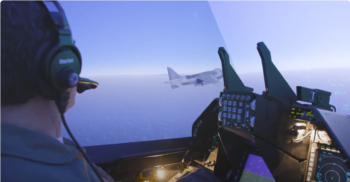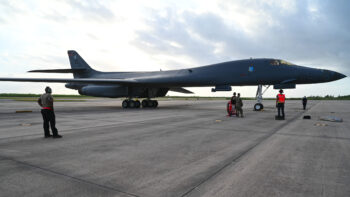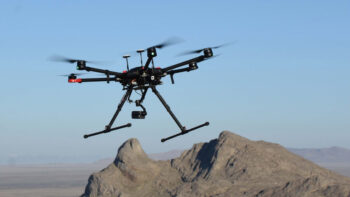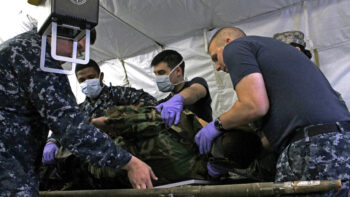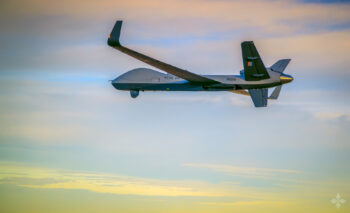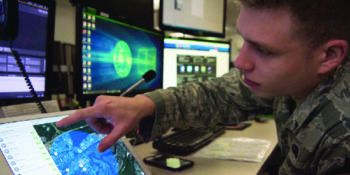
Sailors attached to Expeditionary Medical Force One participate in an emergency room simulation during Operation Northern Lights. (US Navy photo by Mass Communication Specialist 2nd Class John Sorensen/Released).
WASHINGTON — The US Navy’s medical capabilities are undergoing a gradual but steady transformation that is shifting the service’s old way of caring for its injured on the battlefield — focused on massive, discrete hospital ships — and aligning it with the distributed nature of warfare service leadership has embraced in recent years, focused on giving corpsmen precisely what they need to treat a patient when and where they need it.
The shift has been necessitated by the broader changes introduced to the service’s way of fighting through its operational concept “Distributed Maritime Operations,” which generally dictates the fleet should disperse its assets over a larger area to make it harder for an adversary to detect and engage an individual unit.
“When you think about what you need to do to provide medical care to a sailor who’s injured on the battlefield, there’s certain functions that are pretty common,” Capt. Jonathan Haase, program manager for expeditionary missions, told Breaking Defense in an interview. “The question is: How do you actually get those [capabilities] in many places at the right time with the correctly trained people?”
The answer, Haase said, comes down to two key issues: How easily a corpsmen or nurse can gain access to everything they’ll need for a given patient. And if a piece of equipment is suitable for use while being transported in a small boat, helicopter or ground vehicle.
On the first issue, Haase’s office has been developing suites of medical capabilities such as the “En-Route Care System,” which first deployed on the Eisenhower Carrier Strike Group last October.
“The ERCS consists of a critical care nurse and a search and rescue medical technician with an integrated intensive care mobile unit that will be a component of the overall skills and readiness within the medical department aboard Nimitz-class aircraft carrier USS Dwight D. Eisenhower (CVN 69),” a Navy statement about ERCS said at the time.
The purpose of a system such as ERCS is to give deployed forces a premade kit full of the medical equipment they would need to reach a patient and provide the right level of care necessary before returning them to a ship or established facility. Prior to now, it was the corpsman’s responsibility to assemble that kit when they needed it.
That individual responsibility becomes problematic as forces become more distributed. For example, Haase said, a sailor might need to be put on a ventilator and air-lifted in a helicopter. But is the ventilator a corpsman has available suitable for use on a helicopter? It’s a question more easily answered by engineers in Washington than a sailor deployed to the Indo-Pacific.
And that gets to the second key issue Haase raised: Whether a piece of equipment is compatible with the Navy’s forms of transport. Much of the transition happening within the Navy has little to do with developing new medical procedures or devices.
The Navy’s practices largely mirror civilian medicine, but a hospital on land does not have to contend with volatile sea states that could shake the building and cause a mobile bed to slide across the room. A hospital ashore is also not concerned about how an incessant beeping or bright screen may show up to an adversarial sensor. These sorts of minor adjustments to equipment are part of what Haase’s office is working through — taking average medical devices and making them more suitable for use in a battlefield environment.
“We picked the ventilator that would work best in the field that would integrate with the power sources available that could work in a helicopter, and we put that with all the support equipment necessary for it,” he said. “There’s no new ventilator in there at the end of the day. We just made sure that all those things would work seamlessly across all the different platforms.”
Haase could not pinpoint a precise date when these kinds of shifts started taking place, but he did say that 2018 is when the service started to change its internal infrastructure for medical capabilities, or what it calls “expeditionary medicine.” Prior to 2018, the Bureau of Medicine and Surgery, or BUMED, was responsible for nearly all aspects of the Navy’s medical practices, which included developing requirements, resourcing and contracting for capabilities.
In 2018, Haase said, those responsibilities were divided up between BUMED, Naval Sea Systems Command and the Office of the Chief of Naval Operations, also called OPNAV. Those changes actually made expeditionary medicine more closely reflect how the rest of the Navy is structured, rather than having everything contained in BUMED.
The full scope of changes being proposed by Naval Sea Systems Command would cost roughly $800 million to develop and implement, according to a draft requirement that Haase said is still going through the Pentagon’s approval process. To date, the captain said his office is managing roughly $122 million in funding that has already been allocated to his work.
While not directly under Haase’s purview, his office works in conjunction with the NAVSEA office developing the Expeditionary Medical Ship, a new class of vessel derived from the Expeditionary Fast Transport and designed by Austal USA.
EMS will replace the service’s 1,000-bed hospital ships, Mercy and Comfort. While iconic for their humanitarian work and unique white and red paint job, those two ships are at the end of their useful service lives. Further, their deep drafts make them much less mobile than the kinds of ships needed for the service’s more distributed operational concepts.
Despite hold on Diego Garcia, UK’s move to return Chago Islands sparks security concerns
The UK said that “without” the new agreement signed today, “the long-term, secure operation of the [Diego Garcia] military base would be under threat, with contested sovereignty and legal challenges — including through various international courts and tribunals.”
